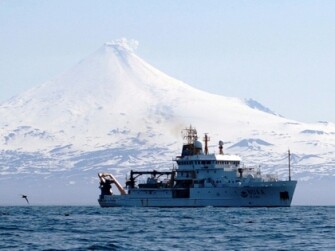Four teachers recently shipped off on a sea adventure, tagging along with scientists conducting research for NOAA, the National Oceanic and Atmospheric Administration. Along the way, they’re building their knowledge of science and related fields and getting a decidedly hands-on STEM experience.

Science teachers Melissa George and Julia Harvey are now aboard the NOAA vessel Oscar Dyson (seen in the photo here), where they’re on an 18-day expedition off the coast of Alaska, helping with research on the Alaska pollock population (also called the walleye pollock, a fish commonly used for fish sticks and imitation crab). Their cruise ends this Friday.
It’s part of NOAA’s Teacher at Sea program, first launched in 1990. In all, 25 teachers are participating this season, which runs from March through November. All of the teachers are blogging about their experiences, and will be developing lessons plans available for any educators to use for free.

Harvey (pictured at right) teaches biology and environmental science at South Eugene High School in Eugene, Ore. Her blog has tons of photos from the voyage, but also plenty of information about the research enterprise and the pollock population. For example, she explains how the ship uses acoustic technology to locate the fish, including how sound travels underwater. In another blog post, she explains how to determine the size of a species population without counting every single organism.
The other teacher on her ship, Melissa George (pictured below), who teaches biology and zoology at Jefferson High School in Lafayette, Ind., also describes at length some of the science and technology involved in the voyage. In one post, she describes how the large trawling net works. (It’s about 150 yards long.) She also highlights some of the sea life found in the trawl. She discusses other matters, too, such as safety gear and drills, meal preparation, teamwork, and maintaining camaraderie on the ship. (In the photo here, she is holding a poriferan, which is a sponge).

Meanwhile, middle school science teacher Katie Sard is aboard the NOAA ship Rainier, conducting a hydrographic survey (essentially charting the ocean floor) in Alaska. And Julie Karre, who is an English/language arts teacher at a Baltimore elementary/middle school, is aboard the NOAA ship Oregon II. It’s conducting research on shark populations off the coast of Florida.
Jennifer Hammond, the director of the NOAA Teacher at Sea Program, said the longstanding initiative has several goals. Top among them is “to educate teachers about NOAA’s research and to give them a hands-on research experience that is applicable to their everyday lives.” She added, “The research is something we use in all sorts of decisionmaking, and we find that most science teachers do not have hands-on research experience.” (Most, but not all, of the teachers who participate are math and science teachers, Hammond says.)
Of course, participation in the program can be pretty motivating to teachers and their students back home. And the blogs surely help to bring the experience home for other educators and for students.
One of Hammond’s favorite blogs was written by Jennifer Goldner, a 5th grade math teacher from Jay, Okla., who sailed aboard a shark cruise in 2011.
“She does a nice job of explaining the science and why it’s important, and conveying to her students why the ocean is important to them,” Hammond said. In fact, Goldner’s students later created a shark coloring book in collaboration with scientists from the voyage, she said, and the scientists later came to visit the teacher’s school.
Hammond acknowledged, however, that the sea experience can have its challenges. For one, it’s not uncommon for teachers on board to get seasick.
The program itself also faces challenges. President Obama has proposed to eliminate the program as part of a broader plan to consolidate federal funding and initiatives promoting STEM education. But this plan is not being embraced in Congress so far. A recent bill passed by the Senate Appropriations Committee explicitly rejected the consolidation plan, and singles out the Teachers at Sea initiative as worthy of continued support.
“The committee does not support the elimination of formal and informal education activities from NOAA including, but not limited to, NOAA’s Teacher at Sea program,” it says.

A companion bill passed out of the Appropriations Committee in the Republican-controlled House also rejects President Obama’s plans for STEM restructuring and consolidation, though it does not rule out eliminating individual programs, saying they would be evaluated on a case-by-case basis.
In fiscal 2013, the Teachers at Sea program received about $600,000, Hammond said. That money supports not only the teachers participating in the program this season, but also the work of an alumni association that supports continued professional development for past participants.
By the beginning of next month, Hammond said, the NOAA Teachers at Sea will have a new feature: a searchable online platform for lesson plans developed by teacher participants in the program.
“If you’re looking for shark lesson plans, they will all show up,” she said.
This Teachers at Sea infographic provides lots more statistics on the program. And on this web page, you can get caught up on news about alumni of the Teachers at Sea program.
The application process for educators who wish to participate in the Teachers at Sea program next year will open on Oct. 1.
Photo Credits: The photos included in this blog all come from NOAA’s Teacher at Sea program website (including the blogs of participating teachers) The final photo, taken by teacher Julie Karre, is of NOAA scientist Kristin Hannan measuring a sandbar shark.